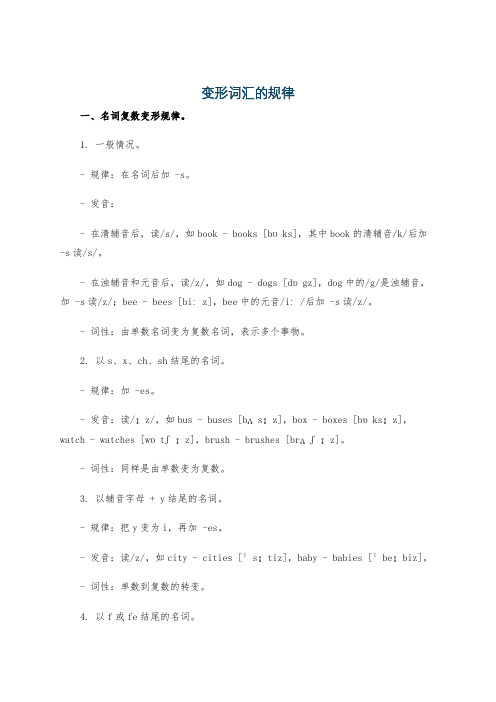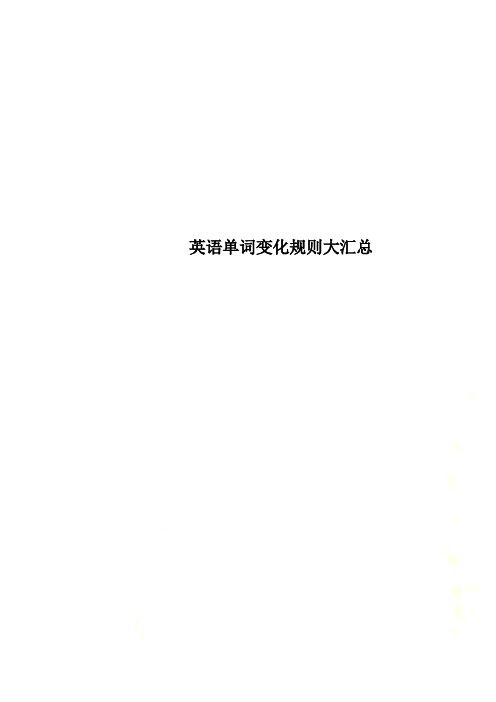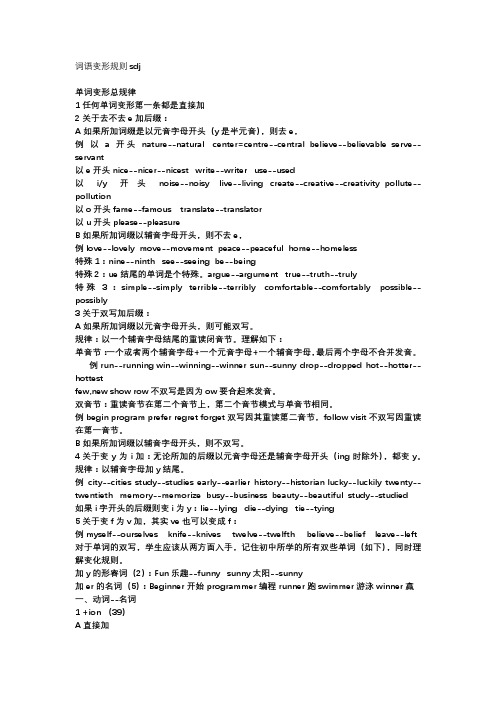英语单词变形规则汇总
单词变形规则大全

单词变形规则大全一、名词复数变形规则。
1. 一般情况。
- 规则:在名词词尾直接加 -s。
- 例词:book[bʊk](书,单数) - books[bʊks](复数);pen[pen](钢笔,单数) - pens[pens](复数)。
- 词性:名词。
2. 以s, x, ch, sh结尾的名词。
- 规则:在词尾加 -es。
- 例词:bus[bʌs](公共汽车,单数) - buses['bʌsɪz](复数);box[bɒks](盒子,单数) - boxes['bɒksɪz](复数);watch[wɒtʃ](手表,单数) - watches['wɒtʃɪz](复数);brush[brʌʃ](刷子,单数) - brushes['brʌʃɪz](复数)。
- 词性:名词。
3. 以“辅音字母 + y”结尾的名词。
- 规则:把y变为i,再加 -es。
- 例词:city['sɪtɪ](城市,单数) - cities['sɪtɪz](复数);baby['beɪbɪ](婴儿,单数) - babies['beɪbɪz](复数)。
- 词性:名词。
4. 以“元音字母 + y”结尾的名词。
- 规则:直接加 -s。
- 例词:day[deɪ](天,单数) - days[deɪz](复数);toy[tɔɪ](玩具,单数) - toys[tɔɪz](复数)。
- 词性:名词。
5. 以f或fe结尾的名词。
- 规则:把f或fe变为v,再加 -es。
- 例词:knife[naɪf](刀,单数) - knives[naɪvz](复数);leaf[liːf](树叶,单数) - leaves[liːvz](复数)。
- 词性:名词。
但也有一些特殊情况,直接加 -s,如roof[ruːf](屋顶,单数) - roofs[ruːfs](复数)。
6. 不规则复数形式。
- 例词:man[mæn](男人,单数) - men[men](复数);woman['wʊmən](女人,单数) - women['wɪmɪn](复数);child[tʃaɪld](孩子,单数) - children['tʃɪldrən](复数);foot[fʊt](脚,单数) - feet[fiːt](复数);tooth[tuːθ](牙齿,单数) - teeth[tiːθ](复数);mouse[maʊs](老鼠,单数) - mice[maɪs](复数)。
英语单词变形的总结归纳

英语单词变形的总结归纳英语单词变形是学习英语过程中的重要部分,它包括词形的变化、时态的变化以及语法形式的变化等。
在使用英语进行交流和写作时,正确地运用单词的各种变形形式,能够丰富表达,提升语言水平。
本文将对英语单词变形进行总结归纳,帮助读者更好地掌握这一知识点。
一、名词的变形1. 单数变复数:通常在名词末尾加-s或-es,有一些特殊的变化规则,如以y结尾的名词变复数时,将y变为i后再加-es,以-f或-fe结尾的名词将f或fe变为v后加-es。
2. 复数变单数:使用the + 单数形式表示复数,或者根据上下文进行判断和确定。
3. 可数名词与不可数名词:根据名词的特性来确定其可数性,可数名词有单数和复数的区别;而不可数名词则没有复数形式。
二、动词的变形1. 时态的变化:包括一般现在时、一般过去时、一般将来时、现在进行时、过去进行时、过去将来时、现在完成时、过去完成时等。
时态的变化与动词的原形、过去式以及过去分词形式有关。
2. 语态的变化:包括主动语态和被动语态的转换。
被动语态的构成是由be动词的各种时态形式与动词的过去分词形式构成。
3. 情态动词的变化:情态动词包括can、could、may、might、shall、should、will、would、must等。
它们可以表示能力、可能性、命令、推测、义务等不同的语气,在时态和语态上有一定的变化规律。
三、形容词和副词的变形1. 形容词的比较级与最高级:形容词的比较级和最高级是表达程度和顺序的重要方式。
规则的变形形式通常在形容词后加-er和-est,而不规则的变形形式则需要记忆。
2. 副词的比较级与最高级:副词的比较级和最高级的变化规律与形容词类似,但在一些副词中需要在前面加上more或most来表示比较级和最高级。
四、其他词类的变形1. 代词的变形:代词包括人称代词、指示代词、相对代词、疑问代词、不定代词等。
在不同的语境中,代词有着不同的变形形式,如格变化、数的变化、性别的变化等。
英语形式变化规则

在英语中,名词、动词和形容词等单词的形式会发生变化,以适应不同的语法需求。
以下是一些常见的形式变化规则:
1. 名词的变化:
-单数变复数:通常在名词末尾加上-s或-es。
例子:book(书)→books(书籍)
-复数变单数:通常去掉复数形式的-s或-es。
例子:desks(桌子)→desk(桌子)
2. 动词的变化:
-一般现在时的第三人称单数:通常在动词末尾加上-s或-es。
例子:go(去)→goes(去)
-现在分词:通常在动词原形后加上-ing。
例子:play(玩)→playing(玩)
-过去式:常见的过去式形式有两种,一种是直接在动词原形末尾加上-ed,另一种是根据变化规则进行变化。
例子:walk(走)→walked(走过);eat(吃)→ate(吃过)
3. 形容词的变化:
-比较级:通常在形容词前加上more或者加上-er。
例子:happy(快乐)→happier(更快乐);beautiful(美丽)→more beautiful(更美丽)
-最高级:通常在形容词前加上most或者加上-est。
例子:happy(快乐)→happiest(最快乐);beautiful(美丽)→most beautiful(最美丽)
需要注意的是,英语中还存在一些不规则变化的单词,它们的形式变化与上述规则不同。
因此,在学习英语时,除了掌握常见的形式变化规则,还需要特别关注不规则变化的单词。
英语单词变化规则大汇总

英语单词变化规则大汇总一、名词复数变化规则1. 一般情况下,直接在名词词尾加 -s ,读音:清辅音后读 /s/ ,浊辅音和元音后读 /z/ 。
- book - books [bʊks] (n. 书)- bag - bags [bæɡz] (n. 包)2. 以 s, x, ch, sh 结尾的名词,在词尾加 -es ,读音:读 /iz/ 。
- bus - buses [ˈbʌsɪz] (n. 公共汽车)- box - boxes [ˈbɒksɪz] (n. 盒子)- watch - watches [ˈwɒtʃɪz] (n. 手表)- dish - dishes [ˈdɪʃɪz] (n. 盘子)3. 以“辅音字母 + y ”结尾的名词,变 y 为 i ,再加 -es ,读音:读 /iz/ 。
- baby - babies [ˈbeɪbiz] (n. 婴儿)- city - cities [ˈsɪtiz] (n. 城市)4. 以 f 或 fe 结尾的名词,变 f 或 fe 为 v ,再加 -es ,读音:读 /vz/ 。
- knife - knives [naɪvz] (n. 刀)- leaf - leaves [liːvz] (n. 树叶)5. 不规则变化- man - men [men] (n. 男人)- woman - women [ˈwɪmɪn] (n. 女人)- child - children [ˈtʃɪldrən] (n. 孩子)- foot - feet [fiːt] (n. 脚)- tooth - teeth [tiːθ] (n. 牙齿)- mouse - mice [maɪs] (n. 老鼠)二、动词第三人称单数变化规则1. 一般情况下,直接在动词词尾加 -s ,读音:清辅音后读 /s/ ,浊辅音和元音后读 /z/ 。
- work - works [wɜːks] (v. 工作)- play - plays [pleɪz] (v. 玩)2. 以 s, x, ch, sh 结尾的动词,在词尾加 -es ,读音:读 /iz/ 。
英语单词变形规则大全

英语单词变形规则大全一、名词复数变形规则。
1. 一般情况。
- 规则:在名词后加 -s。
- 例词:book[bʊk] - books[bʊks];pen[pen] - pens[pens]。
- 词性:名词(n.)2. 以s, x, ch, sh结尾的名词。
- 规则:加 -es。
- 例词:bus[bʌs] - buses[ˈbʌsɪz];box[bɒks] - boxes[ˈbɒksɪz];watch[wɒtʃ] - watches[ˈwɒtʃɪz];dish[dɪʃ] - dishes[ˈdɪʃɪz]。
- 词性:名词(n.)3. 以辅音字母 + y结尾的名词。
- 规则:把y变为i,再加 -es。
- 例词:city[ˈsɪti] - cities[ˈsɪtiz];baby[ˈbeɪbi] - babies[ˈbe ɪbɪz]。
- 词性:名词(n.)4. 以f或fe结尾的名词。
- 规则:把f或fe变为v,再加 -es。
- 例词:knife[naɪf] - knives[naɪvz];leaf[li:f] - leaves[li:vz]。
- 部分特例:roof[ru:f] - roofs[ru:fs](直接加 -s)。
5. 以o结尾的名词。
- 规则:- 有生命的加 -es,如:potato[pəˈteɪtəʊ] - potatoes[pəˈteɪtəʊz];tomato[təˈmɑ:təʊ] - tomatoes[təˈmɑ:təʊz]。
- 无生命的加 -s,如:photo[ˈfəʊtəʊ] - photos[ˈfəʊtəʊz];piano[piˈænəʊ] - pianos[piˈænəʊz]。
- 词性:名词(n.)二、动词第三人称单数变形规则(与名词复数变形规则有相似之处)1. 一般情况。
- 规则:在动词后加 -s。
- 例词:like[laɪk] - likes[laɪks];play[pleɪ] - plays[pleɪz]。
变形词汇的规律

变形词汇的规律一、名词复数变形规律。
1. 一般情况。
- 规律:在名词后加 -s。
- 发音:- 在清辅音后,读/s/,如book - books [bʊks],其中book的清辅音/k/后加-s读/s/。
- 在浊辅音和元音后,读/z/,如dog - dogs [dɒgz],dog中的/g/是浊辅音,加 -s读/z/;bee - bees [biːz],bee中的元音/iː/后加 -s读/z/。
- 词性:由单数名词变为复数名词,表示多个事物。
2. 以s、x、ch、sh结尾的名词。
- 规律:加 -es。
- 发音:读/ɪz/,如bus - buses [bʌsɪz],box - boxes [bɒksɪz],watch - watches [wɒtʃɪz],brush - brushes [brʌʃɪz]。
- 词性:同样是由单数变为复数。
3. 以辅音字母 + y结尾的名词。
- 规律:把y变为i,再加 -es。
- 发音:读/z/,如city - cities [ˈsɪtiz],baby - babies [ˈbeɪbiz]。
- 词性:单数到复数的转变。
4. 以f或fe结尾的名词。
- 有些把f或fe变为v,再加 -es,如knife - knives [naɪvz],leaf - leaves [liːvz]。
- 也有一些直接加 -s,如roof - roofs [ruːfs]。
- 发音:以f或fe变为v再加 -es的情况,读/vz/;直接加 -s的情况,在清辅音/f/后读/s/。
- 词性:单数复数转换。
二、动词第三人称单数变形规律(与名词复数变形规律有相似之处)1. 一般情况。
- 规律:在动词后加 -s。
- 发音:- 在清辅音后,读/s/,如like - likes [laɪks],look - looks [lʊks]。
- 在浊辅音和元音后,读/z/,如go - goes [ɡəʊz],eat - eats [iːts]。
英语中各种变化规则

一、谓语动词第三人称单数变化规则类别构成方法例词一般情况加-s help-helps like-like s 以字母s,x,ch,sh结尾的动词加-esguess-guess e sfix-fix esteach-teach esfinish-finish es以辅音字母加y结尾的动词变y为i,再加-esstudy-stud iesfly-fl ies※特殊:do-does have-has go-goes二、动词过去式规则变化类别构成方法例词一般情况直接加-ed look-look ed play-played 以字母e结尾的动词加-d live-live d hope-hope d 以重读闭音节结尾的动词,且末尾只有一个辅音字母先双写这个辅音字母,再加-edstop-stop pedplan-planned以辅音字母加y结尾的动词变y为i,再加-edstudy-stud iedcarry-carried三、动词-ing形式的构成(现在分词的构成)类别构成方法例词一般情况直接加-ing go-going ask-ask ing 以不发音字母e结尾的动词去掉e,再加-ingmake-mak ingtake-tak ingwrite-writ ing以重读闭音节结尾的动词,且末尾只有一个辅音字母先双写这个辅音字母,再加-ingget-gettingcut-cuttingrun-running以字母ie结尾的动词变ie为y, 再加ingdie-dyinglie-l ying名词变复数规则变化类别构成方法例词一般情况直接加-smap-map s bag-bag sbed-bed s cat-cat s 以s,x,ch,sh结尾的词加-esclass-class es box-boxeswatch-watchesdish-dishes以字母o结尾的词有生命的加-es,无生命的加-s potato-potato estomato-tomatoesphoto-photos zoo-zoo s以辅音字母加y结尾变y为i,再加-es family-famil ies的词strawberry-strawberr ies以f 或fe 结尾的词变f 或fe 为v ,再加-es形容词和副词的比较级和最高级的构成(1)规则变化构成方法原级比较级最高级单音节词和部分双音节词一般在词尾加-er 或-est tall high taller higher tallest highest 以字母e 结尾的词,在词尾加-r 或-stlate cute later cuter latest cutest 重读闭音节词词尾只有一个辅音字母时,先双写该辅音字母,再加-er 或-estbig fat thin bigger fatter thinner biggest fattest thinnest 以辅音字母加-y 结尾的双音节词,改y 为i 再加-er 或-esteasy friendly early eas ier friendl ier earliereas iest friendl iest earliest多音节词和部分双音节词在词前加more 或mostbeautiful interesting outgoing seriousmore beautiful more interesting more outgoing more seriousmost beautiful most interesting most outgoing most serious(2)不规则变化原级比较级最高级good/well better best bad/badly worse worst many/much more most little less least farfarther farthest furtherfurthest。
高中英语单词变形

高中英语单词变形高中英语单词变形是指英语单词在不同的语境中按照一定的规则进行变形,通常包括变音、变调、变词性等。
下面是一些常见的高中英语单词变形方法:1. 动词变形:- 动词+ing:表示正在进行- 动词+ed:表示完成- 动词+ly:表示副词形式- 动词+s:表示第三人称单数例如:- Run -> Runs -> Are running- Eat -> Eats -> Have eaten- Love -> Loves -> Have loved2. 形容词变形:- 形容词+ly:表示副词形式- 形容词+st:表示最高级- 形容词+est:表示最高级例如:- Happy -> Happyly -> Most happy- Nice -> Nicely -> Least nice- Old -> Old-fashioned -> Most old-fashioned3. 名词变形:- 名词+ness:表示形容词形式- 名词+ful:表示形容词形式- 名词+able:表示能够- 名词+ly:表示副词形式例如:- Story -> Storyness -> Interesting- Time -> Timefulness -> Worthy- Book -> Bookness -> Valuable- Feeling -> Feelingfulness -> Caring4. 副词变形:- 副词+ly:表示方式、顺序等- 副词+ward:表示方向- 副词+ingly:表示副词形式例如:- Fast -> Fastly -> In fast motion- Well -> Wellly -> In good health- Deep -> Deeply -> In deep sleep以上是高中英语单词变形的一些常见方法,学生们需要在实际学习中不断积累和掌握更多的变形方式,以便更好地理解和运用英语单词。
英语单词变化规则大汇总

英语单词变化规则大汇总英语单词的各种变化规则一、名词复数变化:(一)规则变化情况构成方法例词读音一般情况在词尾加-sdesk→desksmap→maps-s 在清辅音后发/s/day→daysgirl→girls-s 在元音和浊辅音后发 /z/以s,x,ch,sh结尾的词在词尾加-esbus→busesbox→boxeswatch→watchesfish→fishes-es 发 /iz/ 音以辅音字母加 -y结尾的词变y为i再加 -esfamily→familiesfactory→-ies 发/iz/ 音factories party→pa tries以元音字母加 -y结尾的词在词尾加-sday→daysboy→boyskey→keys-s 发 /z/ 音以f或fe结尾的词变f或fe为v再加-esknife→kniveslife→liveswife→wiveshalf→halves-ves发/vz/音以辅音字母加 -o 结尾的词在词尾加-espotato→potatoestomato→tomatoeshero→heroes-es 发 /z/ 音以元音字母加 -o 结尾在词尾加-sradio→radios-s 发 /z/音的词zoo→zoos注:以ce,se,ze,(d)ge等结尾的词加–s 读 /iz/license-licenses巧记以f\fe结尾的可数名词复数1)妻子骑牛拿起刀,wife,calf,knife ↑2)追得贼狼满街跑,thief,wolf →→→变f或fe为v,再加es3)碰倒架子丧己命,shelf,self,lif e ↓4)手帕树叶半空飘。
handkerchief,leaf,half ↓(二)名词复数的不规则变化:1.child→children(儿童)man→men(男人)woman→women (女人)an Englishman→two Englishmen(英国人)foot→feet(脚)tooth→teeth(牙)mouse→mice(老鼠)ox →oxen(公牛)goose→geese(鹅)2.单复同形deer,sheep,fish,Chinese,Japanese,Swiss, species,means除人民币,美元、英镑、法郎等都有复数形式。
英语变形规律总结

英语变形规律总结英语单词的变形规律可以总结为以下几个方面:1. 名词的复数形式英语中大部分名词的复数形式是在词尾加上-s,例如:book-books, cat-cats, dog-dogs等。
但也有一些名词有不规则的复数形式,例如:child-children, mouse-mice, foot-feet等。
2. 动词的时态变化英语中的动词有三种基本时态:现在时、过去时和将来时。
在现在时,动词原形和第三人称单数形式是一样的,例如:I walk to school. He walks to school. 在过去时,大部分动词的过去式是在原形后加-ed,例如:I walked to school yesterday. He watched TV last night. 但也有一些动词的过去式是不规则的,例如:go-went, eat-ate等。
在将来时,动词前要加will或shall,例如:I will go to school tomorrow. They shall come to visit us next week.3. 形容词和副词的比较级和最高级形式形容词和副词的比较级和最高级形式都是通过在词尾加上-er和-est来表示的。
例如:big-bigger-biggest, fast-faster-fastest。
但也有一些形容词和副词的比较级和最高级形式是不规则的,例如:good-better-best, well-better-best等。
4. 不规则动词的变化规律在英语中,有一些动词的变化规律是不规则的,例如:go-went-gone, eat-ate-eaten等。
这些动词的过去式和过去分词形式都不是在原形后加-ed,而是需要记忆。
总之,英语单词的变形规律需要仔细学习和记忆,只有通过大量的练习才能掌握得更加熟练。
英语动词变形规则总结(3篇)

英语动词变形规则总结(3篇)英语动词变形规则总结第1篇名词复数的规则变化是:①一般在词尾加“s”如:desk+s [-ks] bag+s [-gz] bed+s[-dz] hat+s [-ts]②以字母 s、x、sh、ch结尾的名词变复数,通常在词尾加“es”,如:bus+es [-iz] box+es [-iz] brush+es [-iz] watch + es [-iz]③以字母o结尾的名词变复数, 一般在词尾加“s”,也有加es的,如:photo+s [-z] tomato+es [-z]④以f或fe结尾的名词一般变f或fe为v再加es,例如:knife─knives[-vz] leaf─leaves [-vz]⑤以'辅音字母+y'结尾的名词,变复数时改y为i,再加es, 如: baby ─ babiesfactory─factories1、单复数同形Chinese-chinese Japanese-japanese sheep -sheep deer -deer2、 this 这个these这些(复数) that那个 those那些(复数) I 我 we我们(复数) he他 she 她 it它 they他、它、她们(复数) am ,is是 are(复数)3、其他常见不规则名词复数:man-men, woman-women, policeman-policemen, policewoman-policewomen, mouse-micechild-children, foot-feet, tooth-teeth, fish-fish, people-people, Chinese-Chinese, Japanese-Japanese例:There are ____ in the field. They're eating grass.A. a horseB. much horsesC. many horseD. many horses答案:D例:Look at the _____. You can see ____ and ______.A. photos; potatoes, tomatoes,radioesB. photoes; potatoes, tomatoes, radiosC. photos; potatoes, tomatoes, radiosD. photoes; potatos, tomatos, radioes答案:C名词复数的不规则变化就需要我们记忆了child ─children fish─fish foot─feetman ─ men woman ─ women tooth ─ teethsheep ─ sheep注意:某些名词只有复数形式,例如:people (人们) clothes (衣服) trousers (裤子) police (警察) glasses (眼镜)动词的单数第三人称变化规则英语动词变形规则总结第2篇来自:当以读书通世事 > 《067-英语》发表怎么区分第三人称单数加S和复数加S怎么区分第三人称单数加S和复数加S.前者是加在谓语动词上,是因为“第三人称单数”,后者是加在名词上,表示名词假白吧标元钱在日集某格...动词加s的小总结~加s/es构成的名词复数的读法:1)在单数名词词尾直接加-s,-s在清辅音后面读[ s ],在浊辅音和元音后读[ z ],在辅音[ s ] [ z ][ t∫][d...英语名词变复数的发音规则特殊变化的词根据变化后结尾音变化同上如:butterfly-butterflies变化后结尾音/ai/为元音,所以发/z/音。
英语单词变化规则大汇总

英语单词的各种变化规则注: 以ce,se,ze,(d)ge等结尾的词加–s 读 /iz/license-licenses巧记以f\fe结尾的可数名词复数1)妻子骑牛拿起刀, wife, calf, knife ↑2)追得贼狼满街跑, thief, wolf →→→变f或fe为v, 再加es3)碰倒架子丧己命, shelf,self, life ↓4)手帕树叶半空飘。
handkerchief,leaf,half ↓(二)名词复数的不规则变化:1. child→children(儿童)man→men(男人)woman→women (女人)an Englishman→two Englishmen(英国人)foot→feet(脚)tooth→teeth(牙)mouse→mice(老鼠)ox →oxen(公牛)goose→geese(鹅)2. 单复同形deer, sheep, fish, Chinese, Japanese, Swiss, species, means 除人民币, 美元、英镑、法郎等都有复数形式。
如: a dollar,two dollars; a meter,two meters3.集体名词, 以单数形式出现, 但实为复数。
people police cattle是复数(Correctness: a person, a policeman, a head of cattle,the English, the British, the French, the Chinese, the Japanese, the Swiss )(Error: a people, a police, a cattle )表示国民总称时, 作复数用。
(Th.Chines.ar.industriou.an.brave.中国人民是勤劳勇敢的。
)4. 以s结尾, 仍为单数的名词1)maths, politics, physics等学科名词, 为不可数名词, 是单数。
词语变形规则sdj

词语变形规则sdj单词变形总规律1 任何单词变形第一条都是直接加2 关于去不去e加后缀:A 如果所加词缀是以元音字母开头(y是半元音),则去e,例以a开头nature--natural center=centre--central believe--believable serve--servant以e开头nice--nicer--nicest write--writer use--used以i/y开头noise--noisy live--living create--creative--creativity pollute--pollution以o开头fame--famous translate--translator以u开头please--pleasureB 如果所加词缀以辅音字母开头,则不去e,例love--lovely move--movement peace--peaceful home--homeless特殊1:nine--ninth see--seeing be--being特殊2:ue结尾的单词是个特殊。
argue--argument true--truth--truly特殊3:simple--simply terrible--terribly comfortable--comfortably possible--possibly3 关于双写加后缀:A如果所加词缀以元音字母开头,则可能双写。
规律:以一个辅音字母结尾的重读闭音节。
理解如下:单音节:一个或者两个辅音字母+一个元音字母+一个辅音字母,最后两个字母不合并发音。
例run--running win--winning--winner sun--sunny drop--dropped hot--hotter--hottestfew,new show row不双写是因为ow要合起来发音。
双音节:重读音节在第二个音节上,第二个音节模式与单音节相同。
高中英语单词变形规则总汇

一网打尽
英语名词单数变复数; 动词现在分词、过去式, 形容词、副词的比较级别,形容词变副词规则规律
I. 名词单数变复数
1.一般规律:
可数名词的复数形式,是在词尾加上“s”。
注意音变:结尾是清辅音读[s],结尾是浊辅音或元音读[z]。
2.特殊情况
(1)以s、z、x、ch、sh结尾的词,其复数构成在词尾加上“es”。
注意音变:统一加读[iz]。
(2)以“辅音字母+y”结尾的名词,将“y”改变为“i”,再加“es”。
【注意区分】journey---journeys play—plays donkey—donkeys
(3)①以-o结尾的名词,词后加“es”构成复数。
②外来词或缩写词,后加“s”构成复数。
③以“元音+ O”结尾的,词后加“s”构成复数。
注意音变:加读[z]。
【注意】roof—roofs belief---beliefs cliff—cliffs gulf---gulfs proof---proofs
II动词现在分词、过去式构成规则
“V-ing和-ed”形式的构成的规则
III形容词、副词比较级别构成和形容词+ly构成副词的规则。
英语高考词汇变形总汇

英语高考词汇变形总汇一、名词变形1. 形容词变名词形容词可以通过在前面加上定冠词“a/an”或不定冠词“the”来变成名词,表示一类人或事物。
例如:a poor(可怜的人)- the poor(贫困人群)2. 动词变名词动词可以通过在前面加上不定冠词“a/an”或定冠词“the”来变成名词,表示某个动作或状态。
例如:play(玩耍)- a play(戏剧)3. 形容词或动词的变形形容词或动词可以通过在后面加上后缀“-ness”来变成名词。
例如:happy(快乐的)- happiness(幸福)二、动词变形1. 名词变动词名词可以通过在后面加上动词化后缀“-ize/-ise”来变成动词,表示使成为某种状态或行为。
例如:modern(现代的)- modernize(使现代化)2. 形容词变动词形容词可以通过在后面加上动词化后缀“-en”来变成动词,表示使成为某种状态或行为。
例如:soft(柔软的)- soften(变柔软)3. 副词变动词副词可以通过在后面加上动词化后缀“-ize/-ise”来变成动词,表示使成为某种状态或行为。
例如:slowly(慢慢地)- slow down(减慢速度)三、形容词变形1. 副词变形形容词可以通过在后面加上副词化后缀“-ly”来变成副词,表示程度或方式。
例如:quick(快的)- quickly(快速地)2. 名词变形形容词可以通过在前面加上名词化后缀“-ness”来变成名词,表示某种性质或状态。
例如:happy(快乐的)- happiness(幸福)四、副词变形1. 形容词变形副词可以通过在后面加上形容词化后缀“-able”或“-ible”来变成形容词,表示能够或可能性。
例如:possible(可能的)- possibly(可能地)2. 动词变形副词可以通过在后面加上动词化后缀“-ize/-ise”来变成动词,表示使成为某种状态或行为。
例如:slowly(慢慢地)- slow down(减慢速度)五、其他变形1. 反义词有些词的反义词可以通过在前面加上前缀“un-”来变成反义词。
英语词形变化规则主要规则

一、名词单数变复数主要有以下规则一、绝大多数的可数名词的复数形式,是在该词末尾加上后辍-s。
读音变化:结尾是清辅音读[s],结尾是浊辅音或元音读[z]。
例:friend→friends; cat→cats; style→styles; sport→sports; piece→pieces二、凡是以s、x、ch、sh结尾的词,在该词末尾加上后辍-es构成复数。
读音变化:统一加读[iz]。
例:bus→buses; fox→foxes; match→matches; flash→flashes box →boxes; watch →watches; actress →actresses; class →classes; coach(长途车)→coaches; dress →dresses; sandwich →sandwiches; toothbrush →toothbrushes; waitress(女侍者)→waitresses三、以辅音字母+y结尾的名词,将y改变为i,再加-es。
读音变化:加读[z]。
例:candy→candies; daisy(雏菊)→daisies; fairy→fairies; lady→ladies; story→storiesstrawberry →strawberries; baby →babies; puppy →puppies; library →libraries; dictionary →dictionaries; cherry →cherries; activity →activities四、以-o结尾的名词,如果不是外来词或缩写,就加-es,否则加-s构成复数。
(有生命的加es,无生命的加s)读音变化:加读[z]。
例:tomato→tomatoes; potato→potatoes五、以-f或-fe结尾的名词,多为将-f或-fe改变为-ves,但有例外。
- 1、下载文档前请自行甄别文档内容的完整性,平台不提供额外的编辑、内容补充、找答案等附加服务。
- 2、"仅部分预览"的文档,不可在线预览部分如存在完整性等问题,可反馈申请退款(可完整预览的文档不适用该条件!)。
- 3、如文档侵犯您的权益,请联系客服反馈,我们会尽快为您处理(人工客服工作时间:9:00-18:30)。
写出下列动词的单数第三人称形式
1.
swims 2. draws 3. makes 4. runs 5. carries 6.leaves 7. arrives 8. watches 9.cleans 10. stays
动词的第三人称单数规则 当主语是第三人称(she、he、it)或 名词时,谓语动词要用单数形式。一般情况下动词的第三人称 单数形式都是直接加s
动 词 的 -ing 形 式
写出下列单词的-ing形式 violate refer write
wind swallow scan quarrel breathe begin forgive tie try
写出下列单词的-ing形式 violating swallowing referring breathing writing tying
形容词,副词的比较级和最高级
写出下列形容词的比较级和最高级
bad clean famous dirty big ill heavy little happy far expensive well slow easy wide carefully early thin much clever
规则动词的过去分词与规则动词的过去式的构成规则相同。 1 一般动词,在词尾直接加“ed” work---worked visit---visited 2 以“e”结尾的动词,只在词尾加“d” live---lived 3 以“辅音字母 + y ”结尾的动词,将 “y” 变为 “i” ,再加 “ed” study---studied---studied 4 重读闭音节结尾,末尾只有一个辅音字母,双写该辅音字母, 再加“ed” stop---stopped
请写出下列形容词的副词形式 exact
complete personal probable easy frequent full automatic
形容词变副词
1.直接+ly
quiet—quietly
different—differently
confident—confidently
beautiful—beautifully
写出下列形容词的比较级和最高级
bad/ill-worse-the
famous-
worst clean-cleaner-the cleanest
more famous - the most famous
dirty-dirtier-the dirtiest big-bigger-the biggest heavy-heavier-the heaviest little-less- the least
leaf-leaves; knife-knives life-lives; shelf-shelves thief-thieves; wolf-wolves
动词的单三变
写出下列动词的单数第三人称形式
1.
swim 2. draw 3. make 4. run 5. carry 6.leave 7. arrive 8. watch 9.clean 10. stay
6.以-ly结尾的副词,除early外,其他均
使用more/most构成比较级和最高级 early-earlier-earliest warm-more warmly-most warmly patiently-more patiently-most patiently
不规则变化
good
/ well --- better --- the best 好 bad / badly / ill --- worse --- the worst 坏 many / much --- more --- the most 多 little --- less --- the least 少 old --- older / elder --- the oldest / the eldest 老, 旧 far --- farther / further --- the farthest / the furthest 远
careful—carefully
recent—recently
2. 以-rible — terribly possible— possibly comfortable— comfortably gentle— gently simple— simply reasonable— reasonably probable— probably incredible— incredibly
其它以e结尾的形容词直接+ly wise— wisely nice— nicely polite— politely fortunate— fortunately close— closely immediate—immediately wide—widely
注意以下形容词变副词的拼写
true— truly whole— wholly full— fully dull— dully
energetic— energetically
automatic— automatically
scientific— scientifically economic—economically basic— basically public— publicly (例外)
1.单音节词在词尾加-er构成比较级, 加-est构成最高级 如: hard-harder-the hardest 2.以不发音的e结尾的单音节词直接加-er或-est,如:late-laterthe latest 3. 以辅音字母加y结尾的变y为I加er或est: 如: easy --- easier --- the easiest 4.以一个辅音字母结尾的重读闭音节词双写最后一个辅音字母 再加er或est: 如: big --- bigger --- the biggest 5. 多 音 节 词 前 加 m ore 或 m ost , 副 词 最 高 级 前 省 略 the . 如 : important --- more important --- the most important
不规则变化
1.bacterium-bacteria; medium-media; criterion-criteria phenomenon-phenomena
2. businessman-businessmen policeman-policemen postman-postmen salesman-salesmen spokesman-spokesmen statesman-statesmen
winding scanning quarrel(l)ing beginning forgiving trying
1.一般在动词末尾直接加ing
2.以不发音字母e结尾的动词,先去掉e,
再
加ing 如: have --- having 3. 以重读闭音节结尾的动词,中间只有一 个 d 短元音字母,词尾只有一个辅音字母 , 应双写末尾的辅音字母,再加ing 如:running beginning jogging sitting getting 4.以ie结尾的动词,把ie变成y再加ing , 如: lie --- lying die --- dying
3. 以 辅音+y结尾的,变y 为i+ly
happy— happily
easy— easily angry— angrily merry— merrily heavy— heavily
noisy— noisily
healthy—healthily
lucky—
luckily
4. 以ic结尾的+ally
statesmen, mice,
mosquitoes , monkeys, passers-by, watches, buttons, brochures,universities
1.一般在词尾加-s map-maps,
bridge-bridges 2.以-s,-x,-sh,-ch结尾的加-es glass-glasses, brush-brushes 3. 以o结尾的有生命的名词后加-es hero-heroes, potato-potatoes 以 o 结尾的无生命的名词以及 -oo 结尾 的词后加-s piano--pianos, zoo--zoos
3. goose-geese; tooth-teeth; foot-feet 4. mouse-mice; ox-oxen; child-children deer-deer; fish-fish;sheep-sheep 5. means-means; analysis-analyses stamach-stamachs
动 词 的 -ed 形式
写出下列单词的过去式和过去分词
1.
flow 2. stick 3.bite 4.identify 5. receive 6. aim 7. limit 8.yell 9. ban 10. admit
1.
flow-flowed-flowed 2. stick-stuck-stuck 3. bite-bit-bitten 4. identify-identified-identified 5. receive-received-received 6. aim-aimed-aimed 7. limit-limited-limited 8. yell-yelled-yelled 9. ban-banned-banned 10. admit-admitted-admitted
变形规则
可数名词的复数形式
可数名词才有复数形式 不可数名词主要是抽象名词和物
